
Batch Churned
The difference in our butter is the process we go through to make it. The butter is beurre de baratte (butter of the churn)- it is batch churned from single origin cream, creating a natural and less processed product.
When the beautiful local cream arrives from the farms to the creamery at Gap View Farm in Pennsylvania, we heat up the cream and inoculate it with a lactobacillus culture. We then let the cream culture, allowing for a full buttery taste and slight tang to develop, creating the unique flavour of the cultured butter- this is our crème fraiche. The crème fraiche is then churned, which produces our buttermilk and of course the butter. Finally, the butter is kneaded and placed into hand pressed molds, wrapped and labelled.

Cultures
The cream is pasteurised before the culture is added. This means that when the culture is later added to the cream and it is them fermented, the cultures are still alive and active after churning- so your wheel of Pepe Saya Butter is alive and full of culture.
Button label
Provenance
Our focus has always been on provenance and transparency. We source some of the best American cream and are passionate about building direct relationships with our farmers.
The cream we use comes from local family run farms in Dutch Country Pennsylvania. They run regenerative farms, where the cows roam on pastures.

Tasting Notes
When you first open your butter it will have a tangy and creamy flavour. Over time the culture will develop, which enhances the flavour. Developing cultures will give the butter a cheesier taste and more pungent smell. This is a typical characteristic of cultured butter.
The cream used to make butter affects aroma. All cream is different, depending on the local farm and the seasons, so each batch of butter will be different in flavour and texture according to the cream. Cultured butter (Pepe Saya) scores high in the olfactory test, the butter has a very creamy and cheesy aroma.
Cultured butter with bacteria added to it will produce a more desirable and complex aroma, compared to butter made with traditional cream will give a flatter aroma. The season, manufacturing processes and storage condition also influence the aroma. In the summer milk fat contains more liquid (soft fat) therefore butter tends to be weaker and leaky.
In the winter the milk fat contains more solid fat and tends to be harder, brittle and ultimately less spreadable.
Button label
Spring Flush
'The hills are alive with the sound of music’ is what comes to mind when someone says ‘spring flush’ to me. I think green fields, rolling hills, blooming flowers, bees, birds and butterflies. Flowing rivers and creeks, with the occasional sun-shower and rainbow.
For our dairy farmers, spring flush comes as the days get longer and the air gets warmer, producing more feed for the cows, and in turn more milk and a higher fat content.
The management of their pastures in winter is crucial to a good season. Early spring the grass is similar to grain, the NDF (Neutral Detergent Fibre) is low so they can eat a lot. By mid-spring the pasture becomes more fibrous like hay, so they can’t fit in as much and the fat content of the milk goes up.
You will find variations in cream by season and region. After many years of churning, the team and I can tell where the cream is from that we are churning just from the look and smell.

